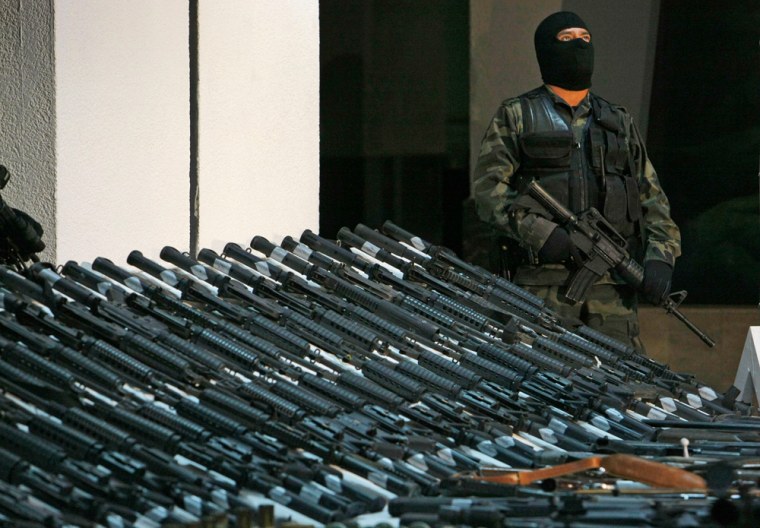Try to bring a refrigerator into Mexico in the back of your pickup, and you are almost certain to get stopped by Mexican customs officials.
Stick a couple of AK-47 rifles in your trunk, and chances are you'll whiz right through.
Now Mexico is owning up to its leaky border as it launches a new program to monitor vehicles entering the country. The goal is to weigh and photograph southbound cars and trucks, in hopes of snaring more gun smugglers.
As the Obama administration promises a crackdown on illegal U.S. weapons sales that supply the drug cartels, Mexico is acknowledging shortcomings on its side of the 2,000-mile border. Facilitating legal trade, not catching gun smugglers, has been the prime directive, customs officials say. Now, the cartel security threat demands a new approach.
Mexico checks only 10 percent of the 230,000 vehicles that cross the border each day, according to the federal Attorney General's Office. By weighing cars to see if they are unusually heavy, and running license plate numbers through a database of suspicious vehicles, the government hopes to catch more hidden contraband.
The United States has long weighed and checked the license plates of northbound vehicles, but the technology is new to Mexico, which is installing it at all customs checkpoints. It was introduced last week at Matamoros, across the Rio Grande from Brownsville, Texas, and should be added along Mexico's border with Guatemala by year's end.
Seeing red
Such a systematic effort would be a big improvement: Inspections are now mostly determined by lights that randomly flash red or green. Frequent travelers say it is rarely red.
Inside Mexico, strict gun control laws prohibit sales of weapons with calibers higher than a .38 handgun. Even to buy those, citizens must get permission from the Defense Department.
North of the border, however, the cartels simply pay straw buyers to pick up weapons at gun shops, gun shows or flea markets, then resell the arms to smugglers.
The ATF says it has traced up to 95 percent of guns seized at scenes of drug violence in Mexico to U.S. commercial sources. These weapons are increasingly higher-powered, including .50 caliber Barrett rifles and ammunition that can pierce the armor of Mexican soldiers and police.
"A year ago, we never saw those guns going south into Mexico," said Tom Mangan, a spokesman for the U.S. Bureau of Alcohol, Tobacco, Firearms and Explosives. "Now we refer to it as one of the weapons of choice."
Mexico's modernization effort coincides with President Barack Obama's pledge to dispatch nearly 500 more federal agents to the border, along with X-ray machines and drug-sniffing dogs, both to stop the spillover of Mexico's drug violence and curb gun smuggling. Homeland Security Secretary Janet Napolitano and Attorney General Eric Holder will be in Mexico Thursday to reinforce the U.S. commitment in talks with their Mexican counterparts.
Experts are skeptical about their chances of slowing the weapons supply. Gun runners easily smuggle thousands of weapons in small numbers at a time, taking them apart and hiding them in suitcases or even inside televisions and DVD players. These weapons wouldn't necessarily be detected by weight.
"If the car has no criminal record, and is apparently legal, it will not necessarily be stopped and checked," said Georgina Sanchez, a gun trafficking expert with the Mexican think-tank Collective for the Analysis of Security and Democracy.
Military-grade weapons
Smugglers also can avoid checkpoints entirely, carrying weapons south along the same desolate corridors that bring drugs and migrants north.
And while cartels get most of their high-caliber assault rifles from the U.S., they are turning to Central America for other military-grade weaponry like grenades and even the occasional rocket launcher.
"You're seeing truly military-type guns, like grenade launchers," Mangan said. "They're not coming from the U.S. The hand grenades that are being used, you're looking at that stuff migrating up from Central America."
Experts also agree that the Mexican military, which is often outgunned by traffickers, has not been a significant source of weapons despite the potential for corrupt soldiers to sell out to the cartels.
Many of the cartels' grenades and other heavy weapons could be leftovers from Central America's civil wars, Mangan said.
Mexico has seized more than 2,702 unexploded grenades since the start of President Felipe Calderon's term in December 2006, compared to 59 during the first two years of the previous administration. Grenades have been traced back to the militaries of many countries, from South Korea to Spain and Israel, Mangan said.
